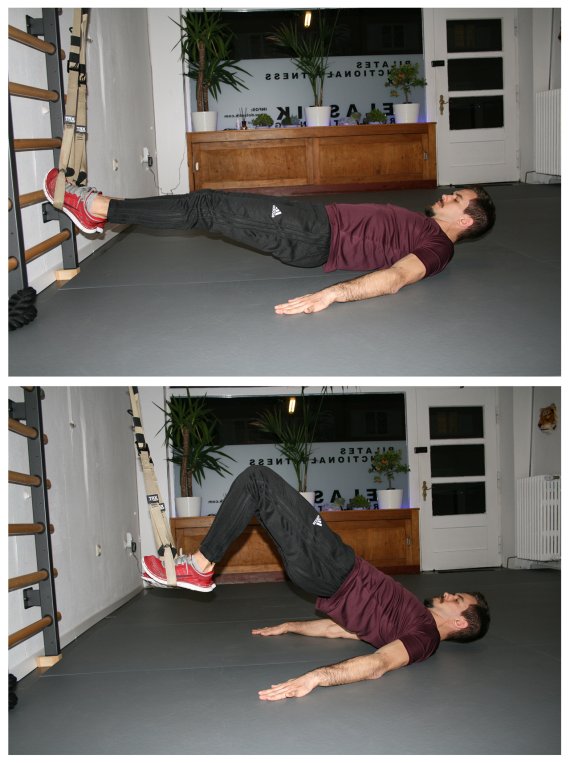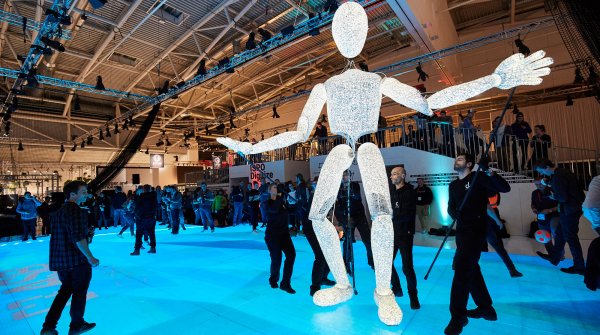TRX bands or TRX suspension trainers offer a versatile range of exercise options that cater to all levels of fitness. Body weight exercises can be made easier or harder by combining them with TRX workout, making them highly adaptable to individual needs. With the suspension trainer's inherent instability, you can perform functional exercises that target the entire muscle chain or isolation exercises that focus on specific muscle groups. Additionally, TRX workouts are perfect for core strengthening exercises. However, caution should be taken when performing jumps with one foot threaded into the TRX, as any misjudgment during the movement could lead to a fall.
In this guide we will take a Step-by-Step look at the best TRX exercises, TRX workouts and TRX moves that you can perform with TRX straps.
Regardless of exercise and equipment: the execution must be right for the training to fulfill its purpose. The TRX is a very good tool to train several important athletic skills.
But there is one ability that stands out in particular: The stabilization of the entire body in space while hanging from the sling. If you row in the TRX, push yourself up out of the arms or hold yourself on one leg, you will notice this very quickly. Only if you make your body stable in the right areas (especially in the core), can you work out cleanly over the full range of motion. Therefore the highest quality criterion is body tension.
Our next standard also helps here: If you want to keep the body core under tension, you should not move too uncontrolled. A correct, controlled speed of movement, especially when giving way, is essential. When moving against gravity (e.g. upwards when pushing up or rowing) you can work a little faster. Rule of thumb: "Quickly up, controlled down."
The last quality to be considered is especially important for one-legged TRX exercises: Movement is best when the balance is still present. Those who are still heavily swaying should first regain their balance before the next repetition of a TRX exercise is performed.

With the right exercises and appropriate training standards, nothing stands in the way of training with the TRX!
The best TRX exercises are:
- TRX Pushup
- TRX Row
- TRX Squat
- TRX Pullup
- TRX Pistol
- TRX RFSS
- TRX Hamstring Curl
- TRX Knee Tuck
- TRX L-Sit
- TRX Biceps Curl
- TRX Triceps Extension
In the following we explain which exercises can be used for training and how.
Starting position
We start with our arms stretched out in the TRX. We can either stand almost straight and lean forward only slightly (beginners) or almost completely into the TRX as with a plank. Our hands, elbows and shoulders form a line and we build up abdominal tension.
Interim position
From the starting position we let ourselves glide down in a controlled manner from the arms to the low push-up position in the TRX - we must not lose our body tension at any time. After a short pause we return to the top by stretching our arms powerfully.

The only TRX exercise for which we need a tool. In the simplified version, the TRX can also be replaced by a door frame, for example.
Starting position
In the starting position we take care to build up body tension already while standing (beginners) or lying down (advanced). For this we tense the abdomen and pull the shoulder blades together. Our arms hang stretched out in the TRX or on an edge / door frame.
Interim position
In the next step we pull ourselves forward or upwards by a powerful bending of our arms. We bring our own hands towards our ribs and hold the shoulder blades together. After a short pause (about 1 second) we slowly return to the start position.
The Face Pull is a variation of the TRX Row, where we mainly work from the upper back and the outer rotators of the shoulders. It is said to have a positive effect on posture, as we train the muscles that help us open the thoracic spine.The design is identical to that of the Row, except that on the one hand we can't go so much into the inclination to the ground here. We are simply weaker in the muscles trained here. On the other hand, of course, the pulling direction differs: instead of leading the elbows backwards and downwards, we lead them towards our neck and face.

The squat is an effective TRX exercise to strengthen both the hips and the legs. Depending on the individual anatomy, the exercise can be performed in a narrower or wider stance. However, many people often have problems getting their knees into the appropriate advanced position to achieve a good depth for bending. Here the TRX can help:
By reaching into the suspension trainer, we can lean back much more and keep our knees above our feet more easily instead of pushing them forward. In the long run, however, we should work on our mobility until we can perform a regular squat. The TRX Pistol Squat serves as a further variant for strengthening.
Starting position
We start in a straight position with the legs about shoulder width and the tips of the feet pointing slightly outwards. The shoulder blades are contracted and the belly is on tension.
Depth Position
To get into the low position we push our knees outwards forward and at the same time our hips backwards. We keep our balance by leading our arms forward. It is important that the back remains straight. We hold our chest high and look forward. From here we push ourselves up again by a powerful hip and leg extension.

The Pullup is well known as well as it is an excellent TRX back exercise. In the shown version it is mainly intended to help beginners to get the full pull-up. The position of the legs on the floor ensures that we do not have to pull our full body weight upwards. We can also help ourselves out of our legs if the worst comes to the worst. Stronger athletes can either set the TRX higher to lose contact with the ground or stretch their legs forward in the L-position (L-Sit Pullup).
Starting position
We hang in the TRX with stretched arms and bent legs. Our feet are on the ground and our hips are set. We pay attention to abdominal tension and initiate the movement to the high position by pulling the shoulders away from the ears before we start bending the arms.
Interim position
After we have pulled our shoulders away from the ears, we begin to bend the arms powerfully. We can also help ourselves out of our legs - but only as much as it's necessary. The arms and back should still do most of the work! Afterwards we lower ourselves as slowly as possible back down to the starting position.

The Pistol Squat is considered the king among the squat variations. But for many, it is a problem due to a lack of mobility or strength. Here the TRX helps:
By reaching into the slings we can support ourselves accordingly, so that the Pistol Squat becomes possible. By successively less help from the arms we gain strength and agility until we can do it without TRX!
Starting position
We stand in the TRX with bent arms in a one-legged stand. One leg goes forward with the toes raised and we stand stable on the other foot. In doing so, we grip the ground with our toes for stability. By moving the seat backwards we initiate the 'transition to the low position'. We maintain abdominal tension and a straight back, i.e. we bend from the hip.
Interim position
When lowering down we support ourselves with our arms in the TRX until we sit on our heel. The other leg is stretched straight forward and held in the air. After a short break, we push ourselves out of the bent leg and back up again with the support of our arms. The arms only help as much as necessary, the majority of the work is done by the leg. Of course we train this on both sides!

The "Rear Foot Elevated Split Squat" is an advanced one-legged strength and balance TRX exercise.
The rear foot is guided in the TRX and serves as unstable support for a one-legged knee bend. It is an excellent way to promote strength and balance equally. The knee stroke at the end also trains the hip flexors, which often weaken due to a lot of sitting.
Starting position
We stand one-legged there, our back foot is threaded in the TRX. First we lift our knee upwards into the hip flexion. In the next step the hip goes back into extension and we bend our standing leg.
Depth Position
In the low position we have stretched our back hip and the back knee taps the ground briefly without resting there. The front hip and the front knee are bent. From here we push ourselves powerfully upwards from the supporting leg and return to the starting position. Of course we train both legs in this way.

The Hamstring Curl is a good TRX exercise for our core, our hips and of course our leg flexors (hamstrings). Here we thread both soles of our feet into the TRX and maintain our body tension for the full duration of the exercise while bending our legs under control.
Starting position
We take a stretched body position with the feet in the TRX loops. Our legs as well as our hips are completely stretched and our stomach is on tension. From here we bend our legs by pulling our heels towards the buttocks. At the same time, our body lifts itself off the ground by stretching our hips.
Interim position
In the upper position our heels are pulled towards the buttocks and our body is only with the shoulder blades on the ground while our arms stabilize us. From here we move slowly and controlled back to the starting position - burning leg curls guaranteed!

The Knee Tuck is a core TRX exercise in which we train our abdominal, hip flexor and shoulder muscles. We have both feet with the instep in the TRX slings and we stabilize ourselves freely in this unstable position.
Starting position
As starting position we are in a high plan position with our feet threaded into the TRX. We pay attention to a solid stomach tension and contracted shoulder blades. Our arms remain continuously stretched during the exercise. We initiate the knee tuck by pulling the knees towards the chest until our weight is in our hands.
Interim position
The intermediate position seems almost like the crow's position from yoga, but there is no relaxation here. The abdominal muscles and hip flexors work at full speed, while our shoulder and arm position stabilizes us. From here we slowly move back to the starting position under control.

The L-Sit is a static core and upper body TRX exercise. Here we can either hang in the chin-up as shown or hold ourselves in the stretched arm as in the dip in the TRX. From this position we bring the legs stretched forward.
This leg position must be kept out of the abdominal muscles and hip flexors. A demanding stabilisation exercise that also challenges the upper body - and looks cool on top of it.

The TRX also has something to offer for friends of isolation training. Similar to the TRX rowing, the arm flexor can be trained isolated from the standing position with the hands in the TRX.
Starting position
In this case we do not move the whole arm behind us, but bend our elbows with the palms of our hands pointing towards us. This causes our arm flexors to pull our body weight forward towards the TRX.
Interim position
In the bent position of the arms we spend a short break. Then we return to an almost stretched out arm position at a slow and controlled pace. It is important not to lose the tension in the muscle.

The TRX also allows us to train our triceps in isolation. In doing so, we support ourselves forwards into the TRX, just like with the pushup. There are basically two possibilities:
Since the triceps also stretches the shoulder downwards, we can start in a high elbow position. However, to put more focus on the elbow part of the triceps, it is also possible to position the elbows in front of the chest. For good results, it is recommended to run both variants regularly.
Starting position
We stand with high or chest high elbows and bended arms leaning into the TRX. We pay attention to a solid abdominal tension and slight tension also in the triceps and shoulder. From here we move our arms into a stretch in front of our face.
End position
The end position in both variants corresponds to a stretched arm at head height. Here we do not spend too much time, but return relatively directly at a slow pace to the bent arm position. A slow return provides a light stretch and good tension in all parts of the triceps.

The suspension system is a true all-rounder. It offers a balanced body weight training for all performance levels. From pensioners to Navy Seals. In combination with HIT or HIIT, the training can also be used for strength and endurance. Thanks to the compactness of the device, you can even do this at home. And with that, one of the biggest hurdles before the training falls.
Lastly, we will answer some of the most asked questions about TRX exercises.
What are some good TRX back exercises?
Pullups, inverted rows and low rows are three of the most popular TRX back exercises. Consider to have some variety in your workouts to target all parts of your back muscles.
What does "TRX" in TRX Workout stand for?
TRX stands for "Total Resistance Exercise" and describes a workout method for which you use your body weight and gravity as resistance to improve your fitness.
Why is the quality of exercise execution important in TRX training?
The quality of exercise execution is crucial, as it promotes body tension, control, and stability. Correct tempo, movement control, and balance are key criteria for effective TRX training.
What are the benefits of TRX training?
TRX training offers balanced bodyweight training for different performance levels and promotes strength, endurance and stability. It is versatile, compact, and allows you to train at home.
Which exercises are suitable for training with the TRX suspension trainer?
The TRX suspension trainer can be used for basically all bodyweight exercises. This allows for a wide range of functional muscle chain exercises as well as isolation exercises for individual muscle groups.
- ISPO awards
- Mountain sports
- Bike
- Design
- Retail
- Fitness
- Health
- ISPO Job Market
- ISPO Munich
- ISPO Shanghai
- Running
- Brands
- Sustainability
- Olympia
- OutDoor
- Promotion
- Sports Business
- ISPO Textrends
- Triathlon
- Water sports
- Winter sports
- eSports
- SportsTech
- OutDoor by ISPO
- Heroes
- Transformation
- Sport Fashion
- Urban Culture
- Challenges of a CEO
- Trade fairs
- Sports
- Find the Balance
- Product reviews
- Newsletter Exclusive Area
- Magazine









